Let’s be honest: Have you ever made Chicken Fra Diavolo, gotten excited by that rich, spicy sauce, only to watch it slide right off your pasta into a sad pool at the bottom of the bowl? That was my secret kitchen frustration for years, until I realized the secret wasn’t in the sauce ingredients—it was in the technique.
This recipe teaches you how to think like an Italian chef, finishing the pasta in the sauce with starchy pasta water to create a luscious, fiery coating that clings to every single noodle. This is how you get Chicken Fra Diavolo Pasta right. It’s a perfect marriage of spicy chicken and tender pasta, with a sauce that never lets go.
Why This Recipe Works
- The Perfect Sauce, Guaranteed: Unlike other recipes, I’ll show you the critical, game-changing step of finishing the pasta in the sauce with starchy pasta water. This creates a creamy, emulsified sauce that clings beautifully, eliminating any watery-bowl disappointment.
- Deep, Balanced, Controllable Heat: We’re building flavor with layers of spice—not just scorching heat. By using both dried Calabrian chiles and crushed red pepper flakes, you get a complex warmth you can easily dial up or down to your exact preference.
- No Generic Seasoning Blends: We use individual herbs like oregano and basil to build a fresh, aromatic sauce from the ground up. This gives you a much brighter, more authentic flavor than any generic “Italian seasoning” ever could.
- Tested to Perfection: As with all my recipes on Kitchenslovers.com, this dish has been tested dozens of times by a real-life, busy family. It’s streamlined for success in your kitchen.
The Building Blocks of a Superior Sauce
For a truly exceptional Chicken Fra Diavolo Pasta, you need to think like a chef. We aren’t just throwing things in a pot; we’re strategically building layers of flavor—deep, spicy, aromatic, and impossibly rich. Here’s what we need, with precise amounts:
- Olive Oil: 3 tablespoons extra virgin olive oil, divided.
- Chicken: 1.5 pounds boneless, skinless chicken breasts or thighs, pounded or sliced into thin ½-inch cutlets.
- Salt and Black Pepper: To season the chicken and the sauce.
- Aromatics:
- 1 large shallot, finely chopped.
- 6-8 cloves garlic, thinly sliced.
- The Trio of Heat:
- 1 teaspoon crushed red pepper flakes (use ½ tsp for mild, 1.5 tsp for extra spicy).
- 2-3 whole dried Calabrian chiles, finely chopped (or 1 tbsp chopped Calabrian chiles in oil).
- 1 fresh serrano or Fresno chili, thinly sliced (optional, for garnish).
- Individual Herbs:
- 1 ½ teaspoons dried oregano.
- 1 teaspoon dried basil.
- ¼ cup fresh Italian parsley, finely chopped, plus more for garnish.
- Tomatoes: 1 (28-ounce) can San Marzano-style crushed tomatoes. The quality of your tomatoes is the soul of the sauce. Navigating the labels for these can be tricky, and if you want to go down a fascinating rabbit hole, this article explains why authentic San Marzanos are called the ‘Fake Rolex’ of canned tomatoes. It’s a brilliant read for any serious home cook.
- Pasta: 1 pound dry rigatoni, penne, or other short, sturdy pasta shape.
- Pasta Water: About 1 ½ cups, reserved just before draining the pasta. This is liquid gold!
🌟 Two Secrets to Unforgettable Flavor
Anyone can make a dish spicy. Our goal is to create a sauce with breathtaking depth and character. We achieve this with two non-negotiable strategies.
1. The Art of Layering Heat: The Calabrian Chile Advantage
We build heat with purpose. First, blooming the standard crushed red pepper flakes in hot oil infuses the entire dish with a consistent, foundational warmth. But the game-changer is the Calabrian chiles. These add a complex, smoky, almost fruity character to the heat that is worlds apart from one-dimensional spice. It’s a slow-building heat that warms you from the inside out, making the sauce truly memorable.
2. The Individual Herb Advantage: Why We Skip Generic Blends
This is a major key to authentic flavor. Generic “Italian Seasoning” blends are often dominated by one or two dusty-tasting herbs and lack vibrancy. By using high-quality, individual dried oregano and dried basil, we control the ratios, creating a much more nuanced and aromatic sauce. The oregano provides an earthy, robust backbone, while the basil lends a sweeter, peppery note. Finishing with fresh parsley adds a final burst of clean, bright flavor that pre-made blends simply can’t replicate. It’s the difference between a flat sauce and a vibrant one.
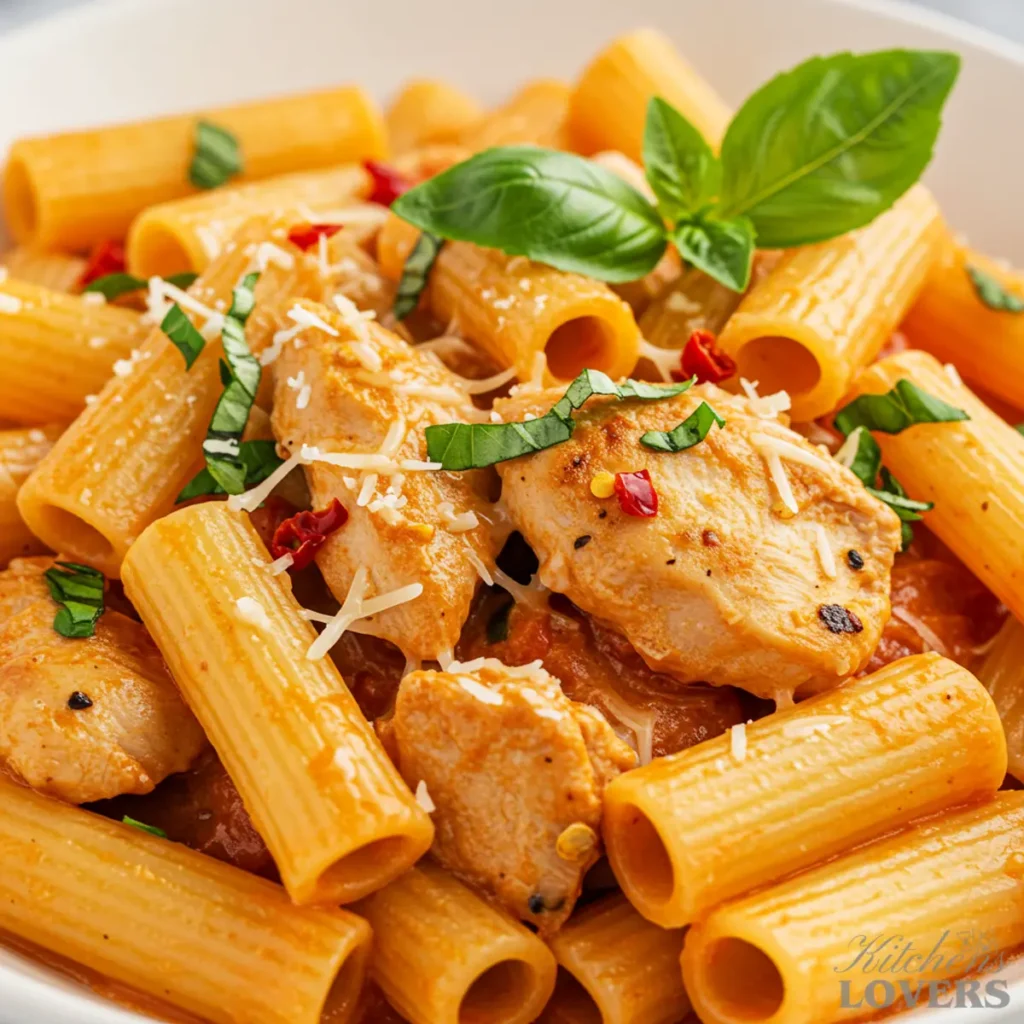
Smart Swaps & Substitutions
Don’t have the exact ingredient? No problem. Cooking is all about adapting. Here are the swaps I’ve tested and approved:
| Ingredient | My Recommended Swap | Expert Tip |
| Boneless, Skinless Chicken Breasts | Boneless, Skinless Chicken Thighs | Thighs are naturally more flavorful and stay juicier, making them very forgiving. Just trim any excess fat. |
| Calabrian Chiles | Double the Red Pepper Flakes | If you can’t find them, doubling the standard red pepper flakes will get you the heat, though you’ll miss the smoky complexity. |
| Rigatoni or Penne | Spaghetti or Fettuccine | Long pasta works! Just be prepared to toss it extra thoroughly to ensure every strand gets coated in that beautiful sauce. |
| Crushed Tomatoes | Diced or Whole Peeled Tomatoes | Diced tomatoes create a chunkier sauce. If using whole, crush them with your hands or a spoon as they go into the pot. |
| Shallot | Half a Small Yellow Onion | A shallot provides a milder, slightly sweeter flavor, but a yellow onion is a perfectly acceptable and classic substitute. |
Essential Equipment for a Perfect Finish
The beauty of this recipe is that it’s a true one-pan wonder for the sauce and chicken. But for the technique to work, the pan has to be right.
The Hero Tool: A Large, Wide Skillet or Dutch Oven
Trust me on this: your best friend for this recipe is a 12-inch or larger skillet or a wide Dutch oven (at least 5 quarts). This is non-negotiable.
Here’s why it’s so critical to our method:
- A Perfect Sear: The wide surface area gives the chicken cutlets plenty of real estate to get a beautiful golden-brown crust. If your pan is too small, the chicken will steam instead of sear, and you’ll lose a massive layer of flavor.
- Room to Build the Sauce: You have enough space to properly bloom the chiles and sauté the aromatics, creating the flavorful base without crowding or burning.
- The Grand Finale (The Most Important Step!): This is where the magic happens. A large pan is the only way you can add all of the cooked pasta directly into the sauce with plenty of room to vigorously toss and stir. This action, combined with the starchy pasta water, is what creates that luscious, emulsified sauce that coats every single noodle. A smaller pan simply won’t allow you to do this properly.
My Top Picks: A heavy-bottomed stainless steel skillet, a classic cast-iron skillet, or an enameled cast-iron Dutch oven are all perfect choices. They retain heat beautifully and give you a fantastic foundation of flavor.
The Supporting Cast
- Large Pot: You’ll need a standard large stockpot or pot to boil the pasta and create our essential starchy pasta water.
- Spider Strainer or Tongs: A “spider” skimmer is the ideal tool for transferring the cooked pasta directly from its water into the skillet of sauce. It carries over some of that precious pasta water with it. If you don’t have one, tongs work well, too. This is much better than draining all the water in a colander!
- The Basics: Of course, you’ll need a good cutting board and a sharp knife for prepping the chicken and aromatics.
Expert Tips for Flawless Results
After making this dish more times than I can count, I can tell you that the difference between a good Chicken Fra Diavolo Pasta and a truly great one comes down to a few key moments in the cooking process. These aren’t just suggestions; they are the core techniques that proactively solve common problems and guarantee a spectacular result. Master these, and you’ll nail it on your very first try.
1. The Secret to a Clingy Sauce (It’s All in the Finish)
So, how do we solve that age-old problem of a watery sauce that pools at the bottom of the bowl? It’s not about adding cornstarch or cooking the sauce for hours. The magic is a classic Italian restaurant technique that happens in the final two minutes of cooking.
It relies on two things: undercooking your pasta slightly and using that glorious, cloudy, starchy pasta water.
Here’s the method: Cook your pasta for about 1-2 minutes less than the package directions for al dente. Just before you’re ready to drain it, use a mug to scoop out at least 1 to 2 cups of the cooking water. Do not forget this step! This starchy water is what I call “liquid gold.” It’s full of released starch from the pasta, and it’s the perfect natural emulsifier that will bind our sauce together.
Now, use a spider skimmer or tongs to transfer the undercooked pasta directly into the skillet with your simmering Fra Diavolo sauce. Add about a cup of the hot pasta water. Turn the heat to high and toss, stir, and swish the pasta vigorously and constantly in the sauce for that final minute or two. You will witness a transformation right before your eyes. The sauce will tighten up, becoming creamy and glossy, and will cling perfectly to every single piece of rigatoni. That, right there, is the secret.
Quick Troubleshooting:
- If Your Sauce Seems Too Thin: This usually means it just needs another 30-60 seconds of vigorous tossing with the pasta over the heat. The starches need that heat and friction to fully emulsify and thicken the sauce.
- If Your Sauce Seems Too Thick or Pasty: You’ve created a powerful emulsion! Simply add a small splash of plain hot water (or chicken broth) to loosen the sauce to your desired consistency.
2. How to Perfectly Control the “Devil’s” Heat
“Spicy” doesn’t have to mean painful. You are in complete control here. Sautéing the dried chiles in the oil at the beginning is crucial—this “blooms” them, releasing their flavorful oils and infusing the entire foundation of the dish with warmth.
Here’s your guide to heat levels:
- For a Milder Kick: Use just ½ teaspoon of red pepper flakes and skip the Calabrian chiles entirely. You’ll still get a lovely warmth without the devilish punch.
- For a Classic Medium Heat (As Written): Use the full teaspoon of red pepper flakes and the chopped Calabrian chiles. This is my favorite balance—complex, warm, and spicy but not overwhelming.
- For True “Fra Diavolo” Fiery Heat: Go for 1.5 teaspoons of red pepper flakes and add the optional fresh, thinly sliced chili at the very end with the parsley. This will give you a sharp, bright heat on top of the deeper warmth.
3. The Key to Juicy, Tender Chicken Every Time
The biggest crime against a good pasta dish is dry, rubbery chicken. We avoid this completely with two simple rules. First, pound your chicken breasts into thin, even ½-inch-thick cutlets. You can do this by placing the chicken between two pieces of parchment paper and using a meat mallet or even a heavy rolling pin. Why? Thinner cutlets cook much more quickly and evenly, so you don’t have a dry, overcooked edge by the time the center is cooked through.
Second, do not overcook the chicken in the first step. Sear it for just 2-4 minutes per side, until it’s golden and just cooked through. It will spend a few more minutes in the warm sauce with the pasta at the end, so it’s better to pull it slightly early than to overdo it. Remember, you’re not trying to create a super-crispy chicken cutlet; you’re searing it to develop foundational flavor for the pan sauce.
How to Make Perfect Chicken Fra Diavolo Pasta
I’ve broken this recipe down into three distinct phases to make it completely foolproof. First, we’ll create a deep foundation of flavor by searing the chicken. Next, we’ll build our spicy, aromatic Diavolo sauce right in the same pan. And finally, we’ll execute the most important step: finishing the pasta in the sauce to create that flawless, clingy texture. Follow along, and I promise you a spectacular result.
Time Needed: 50minutes.
Phase 1: Prep and Sear the Chicken
This first phase is all about building a layer of savory flavor right in your skillet.
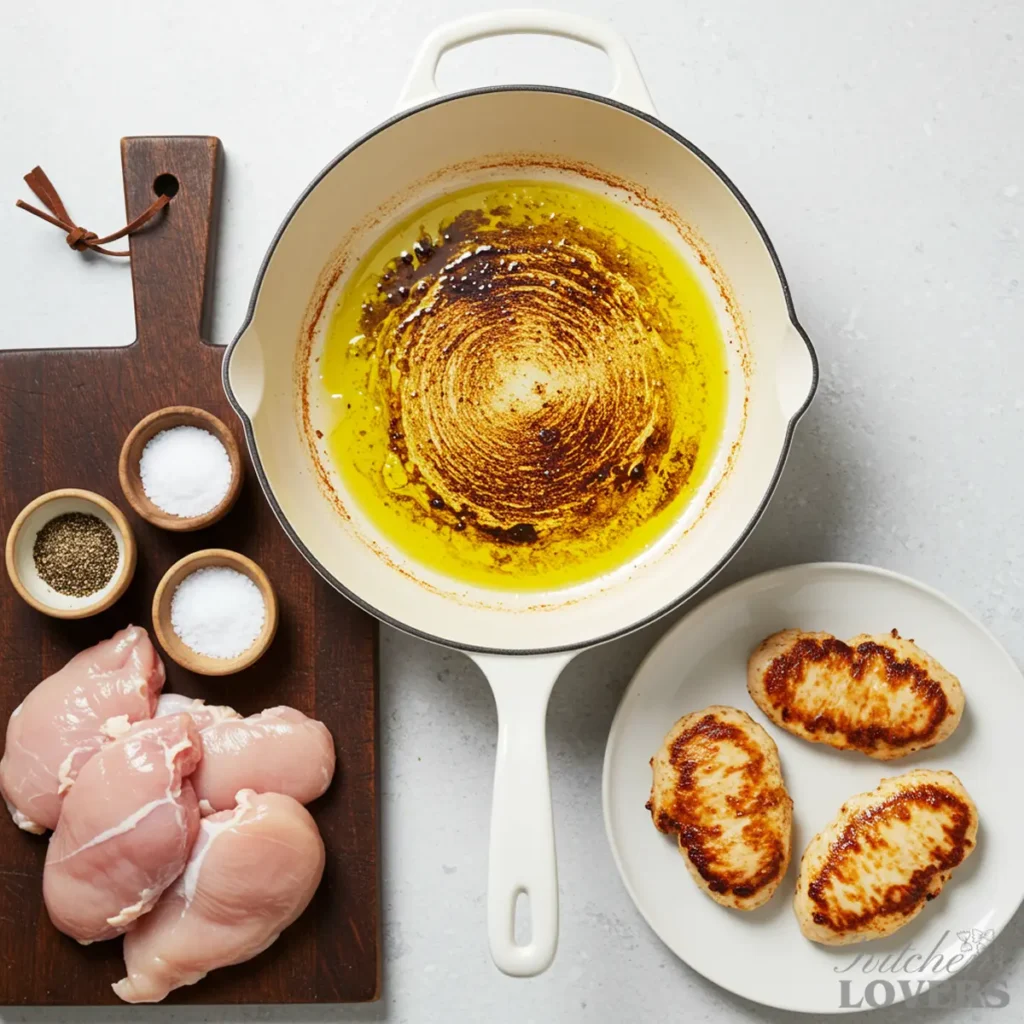
- Prep the Chicken: If you haven’t already, pound your chicken breasts or thighs into ½-inch-thick cutlets. Pat them completely dry with a paper towel (this is key for a good sear!). and season both sides generously with salt and black pepper.
- Heat Your Pan: Place your large skillet or Dutch oven over medium-high heat and add 2 tablespoons of olive oil. The oil should be shimmering—if you flick a drop of water in, it should sizzle immediately.
- Sear the Chicken: Carefully place the chicken cutlets in the hot pan, making sure not to overcrowd it (work in two batches if you must). Let them cook, undisturbed, for 3-4 minutes per side. You’re looking for a beautiful, deep golden-brown crust. The chicken should be just cooked through. Transfer the seared chicken to a plate and set it aside. Do NOT wipe out the pan! All those browned bits on the bottom are pure flavor.
Phase 2: Build the Diavolo Sauce
Now we use the same pan to build that rich, spicy, aromatic sauce.
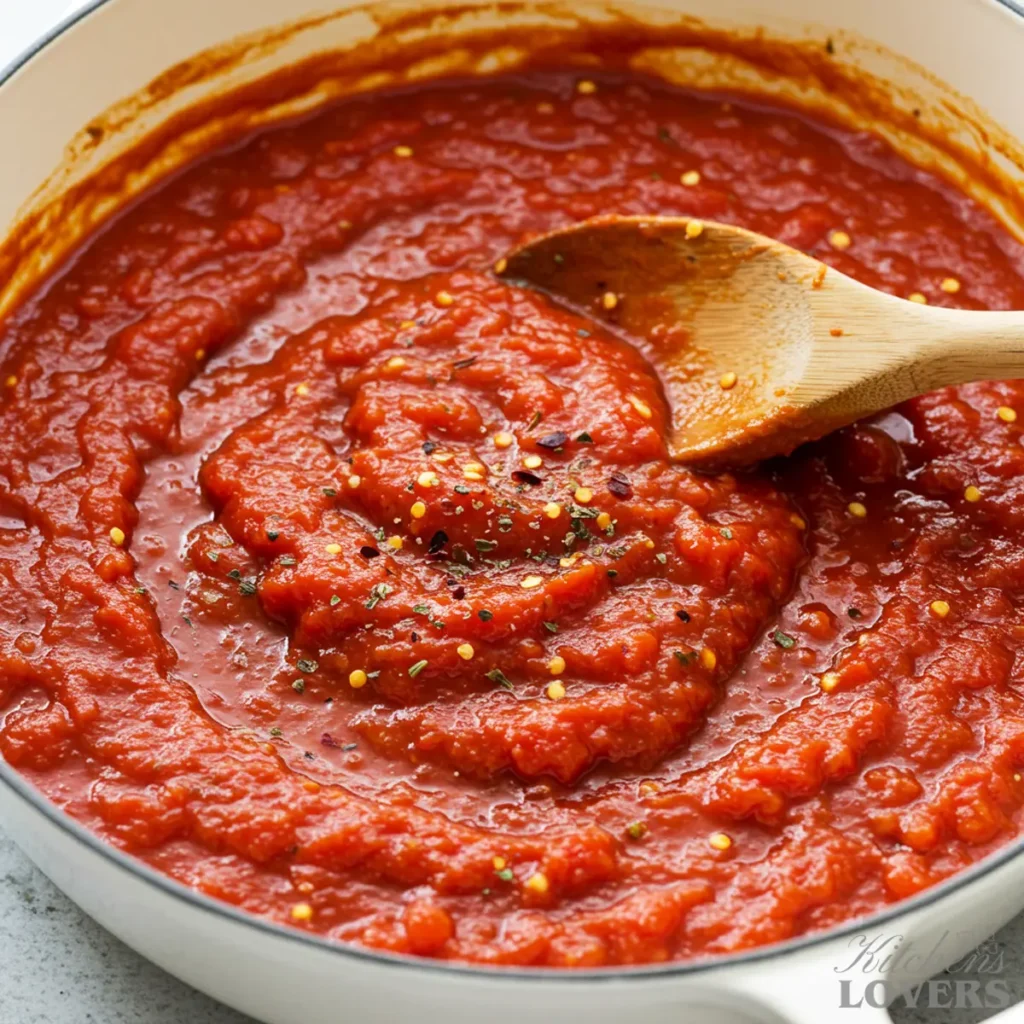
- Boil the Pasta Water: Before you start the sauce, get a large pot of water on the stove over high heat to boil for your pasta. Salt it generously—it should taste like the sea.
- Bloom the Spices: Reduce the heat under your skillet to medium. Add the remaining 1 tablespoon of olive oil. Add the crushed red pepper flakes and the chopped dried Calabrian chiles. Let them sizzle in the oil for just 30-45 seconds. Your kitchen will immediately smell spicy and fragrant. This step infuses the oil with a deep, layered heat.
- Sauté the Aromatics: Add the chopped shallot to the skillet and cook, stirring occasionally, for about 3 minutes until it has softened and turned translucent. Now, add the sliced garlic and cook for just another 60 seconds until it’s fragrant. Be very careful not to let the garlic brown, or it will turn bitter.
- Simmer the Sauce: Pour in the entire can of crushed tomatoes. Add the dried oregano, dried basil, and about ½ teaspoon of salt. Stir everything together, scraping up any of those delicious browned bits from the bottom of the pan with your spoon. Bring the sauce to a lively simmer, then reduce the heat to low. Let it bubble gently for at least 10-15 minutes for the flavors to meld together.
Phase 3: Finish the Pasta in the Sauce (The Magic Step)
This is the grand finale where we create that perfectly emulsified, restaurant-quality sauce. Timing is everything here.
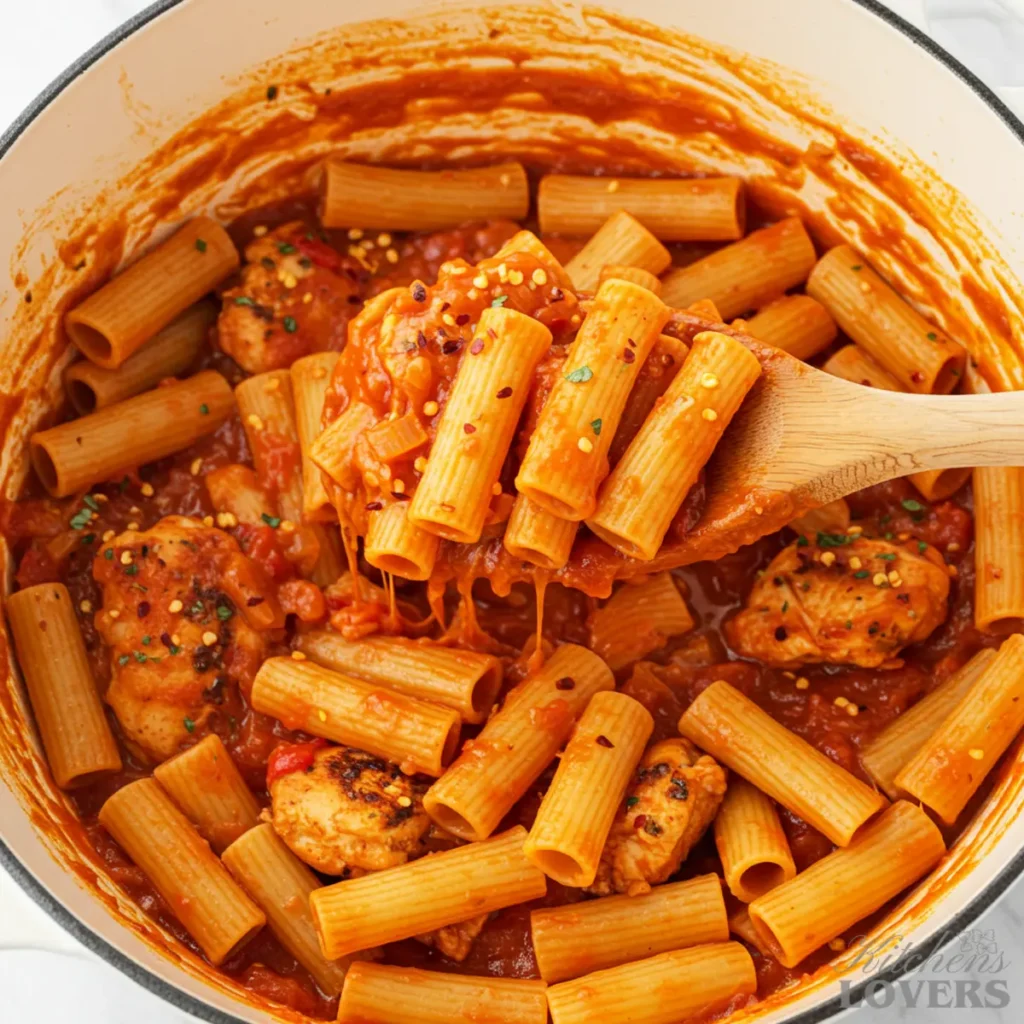
- Cook the Pasta: By now, your pasta water should be at a rolling boil. Add the rigatoni and cook it for 2 minutes less than the package directs for al dente. It will feel slightly underdone, and that is exactly what you want.
- Combine and Emulsify: Just before the pasta is ready, use a heatproof mug to reserve at least 2 cups of the starchy pasta water. Now, using a spider strainer or tongs, lift the undercooked pasta directly from the water and transfer it into the skillet with the simmering sauce. Don’t worry if some water comes with it.
- Toss Vigorously: Add the chopped cooked chicken back to the pan along with about 1 cup of the reserved pasta water. Turn the heat up to medium-high and begin tossing, stirring, and shaking the pasta constantly.
- Watch it. Transform: Continue to toss vigorously for 1-2 minutes. You’ll see the sauce thicken, turn glossy, and begin to coat every single piece of pasta beautifully. If the sauce gets too thick, add another splash of pasta water until it’s the perfect consistency.
- Serve Immediately: Turn off the heat. Stir in the fresh parsley and the optional fresh sliced chili. Give it one final toss, taste for salt, and serve immediately in warm bowls with an extra sprinkle of parsley on top. Enjoy the silence as everyone takes their first, perfect bite.
Pro Variations & Customization
A great recipe isn’t just a rigid set of instructions—it’s a launchpad for creativity. Once you’ve mastered the core technique for this Chicken Fra Diavolo Pasta, you can easily adapt it. Here are two of my favorite, thoroughly tested variations.
The “Rosé Devil”: Creamy & Spicy Variation
This is a luxurious twist that transforms the fiery “Diavolo” sauce into a rich, spicy rosé-style sauce. The addition of cream doesn’t just dilute the heat; it tames it, rounding out the sharp edges into a luscious, deep warmth that is incredibly comforting. It’s the best of both worlds: still spicy, but now velvety smooth.
What You’ll Need: Have ¼ to ½ cup of cold heavy cream or mascarpone cheese ready to go. Mascarpone will result in an even richer, thicker sauce.
How to Adapt the Recipe:
- Follow the recipe exactly as written through Step 11, where you have finished vigorously tossing the pasta, chicken, and sauce together and it has become thick and glossy.
- Turn the heat off completely. This is the most important step.
- Slowly pour in the cold heavy cream or add the dollops of mascarpone. Stir gently and continuously until the cream is fully incorporated and the sauce turns a beautiful, uniform pale red.
- Do not bring the sauce back to a boil. Adding cream to a highly acidic tomato sauce while it’s boiling can cause it to separate or curdle. By stirring it in off-heat, you ensure a perfectly smooth and velvety texture. Serve immediately.
Ultimate Surf & Turf: Adding Shrimp
This is my favorite way to turn this amazing weeknight dinner into a truly special-occasion meal. The sweet, tender shrimp are a perfect counterpoint to the spicy chicken and rich tomato sauce. The key is to add them at the very last minute so they cook perfectly and don’t become rubbery.
What You’ll Need: Add ½ to 1 pound of large raw shrimp, peeled and deveined, to your ingredient list.
How to Adapt the Recipe:
- Follow the recipe exactly as written through Phase 1 and Phase 2.
- When you get to Phase 3, Step 10, this is where you’ll make the change. As you add the seared, chopped chicken back into the skillet with the undercooked pasta and starchy water, add your raw shrimp at the same time.
- Toss everything together vigorously over the heat just as the original recipe directs. The shrimp cook incredibly fast! By the time your pasta has finished cooking and the sauce has emulsified (about 1-2 minutes), the shrimp will be perfectly pink, opaque, and tender. Serve immediately. It’s that simple.
Storing, Freezing & Making Ahead
This isn’t just a “make and eat” dish. With the right strategy, your Chicken Fra Diavolo can be a brilliant tool for meal prep or a stress-free dinner party. But you must respect the ingredients. Pasta is delicate and continues to change after it’s cooked, so let’s walk through how to handle it properly.
Storing Leftovers (The Right Way)
If you have leftovers (and that’s a big “if”!), let the pasta cool slightly at room temperature for no more than an hour. Transfer it to an airtight container and store it in the refrigerator for up to 3 days. The pasta will continue to absorb some of the sauce as it sits, making it even more flavorful, though the texture will be slightly softer than when it was freshly made.
The Best Reheating Method (Stovetop is King)
Please, do not microwave your leftover pasta. I can’t stress this enough. Microwaves heat unevenly, which will make the chicken tough and the pasta rubbery and can cause the beautiful sauce we built to break and turn greasy.
The stovetop is your only friend here. It’s the only way to gently revive the dish.
- Add Pasta & Liquid: Place the leftover pasta in a skillet or saucepan over medium-low heat. For each portion you’re reheating, add a splash (about 1-2 tablespoons) of water, chicken broth, or even milk.
- Gently Reheat: Cover the skillet and let the contents steam gently, stirring occasionally, for 4-6 minutes, or until the chicken and pasta are heated through.
- Why this works: The splash of liquid is critical. It turns to steam, which gently reheats the pasta and, more importantly, helps re-emulsify the sauce, returning it to its glossy, clingy state.
A Detailed Freezing Guide (My Expert Recommendation)
This is a common question, and I have a strong opinion based on years of testing. While you can freeze the finished dish, the pasta will become very soft and mushy upon reheating. For a vastly superior result, you should freeze the sauce and chicken separately.
- The Quick & Easy Method (Not Recommended): If you must freeze the finished pasta, let it cool completely, portion it into freezer-safe airtight containers, and freeze for up to 2 months. Thaw overnight in the fridge and reheat using the stovetop method above, knowing the pasta texture will be compromised.
- My Pro Method (For Perfect Results):
- Follow the recipe through Step 7, creating the complete Diavolo sauce and adding the seared chicken pieces to it.
- STOP HERE. Do not add any pasta or pasta water.
- Allow this finished sauce-and-chicken mixture to cool completely.
- Portion it into airtight containers or, my favorite trick, into freezer-safe zip-top bags. Squeeze out all the air and lay them flat. They freeze into neat bricks that are incredibly easy to stack and store. This will last for up to 3 months in the freezer.
Make-Ahead Strategy for a Dinner Party
This is my secret to staying relaxed when hosting. You can make almost the entire dish ahead of time.
- The Day Before: Make the entire recipe through Step 7. Cool the finished sauce with the chicken in it, then store it in an airtight container in the refrigerator.
- Just Before Serving: Pour the chilled sauce into your large skillet and gently reheat it over medium heat. While it’s coming to a simmer, boil a fresh pot of pasta. When the pasta is 2 minutes from al dente, proceed with the “magic” Step 8 of the recipe. Your guests will think you’ve been slaving over a hot stove for hours, but you’ll have a perfect, freshly finished pasta dish on the table in about 15 minutes.
What to Serve With This Dish
This is where you elevate the meal from a simple pasta dish to a full, balanced experience. A bold, fiery pasta like this doesn’t need competition on the plate; it needs cool, crisp, and refreshing partners that cleanse the palate and provide a welcome contrast between bites. Forget the obvious choices; these pairings are designed to make the Fra Diavolo shine even brighter. Choosing the right partner is what separates a good dish from the truly Crave-worthy chicken pasta dishes you remember.
A Cooling Cloud of Cream: Whipped Ricotta with Lemon
Why it works: Instead of making the sauce itself creamy, serve a dollop of fresh, whipped ricotta on top or on the side of each portion. This provides a luscious, cooling pocket of relief that each diner can mix in as they please. The mild, milky flavor is the perfect antidote to the “devil’s” heat, while a little lemon zest adds a floral brightness that cuts through the rich tomato sauce beautifully.
How to make it: In a small bowl, whip 1 cup of good-quality, whole milk ricotta with the zest of half a lemon, a drizzle of olive oil, and a pinch of salt until it’s light and smooth.
Bitter Greens to Cut the Richness: Sautéed Broccoli Rabe
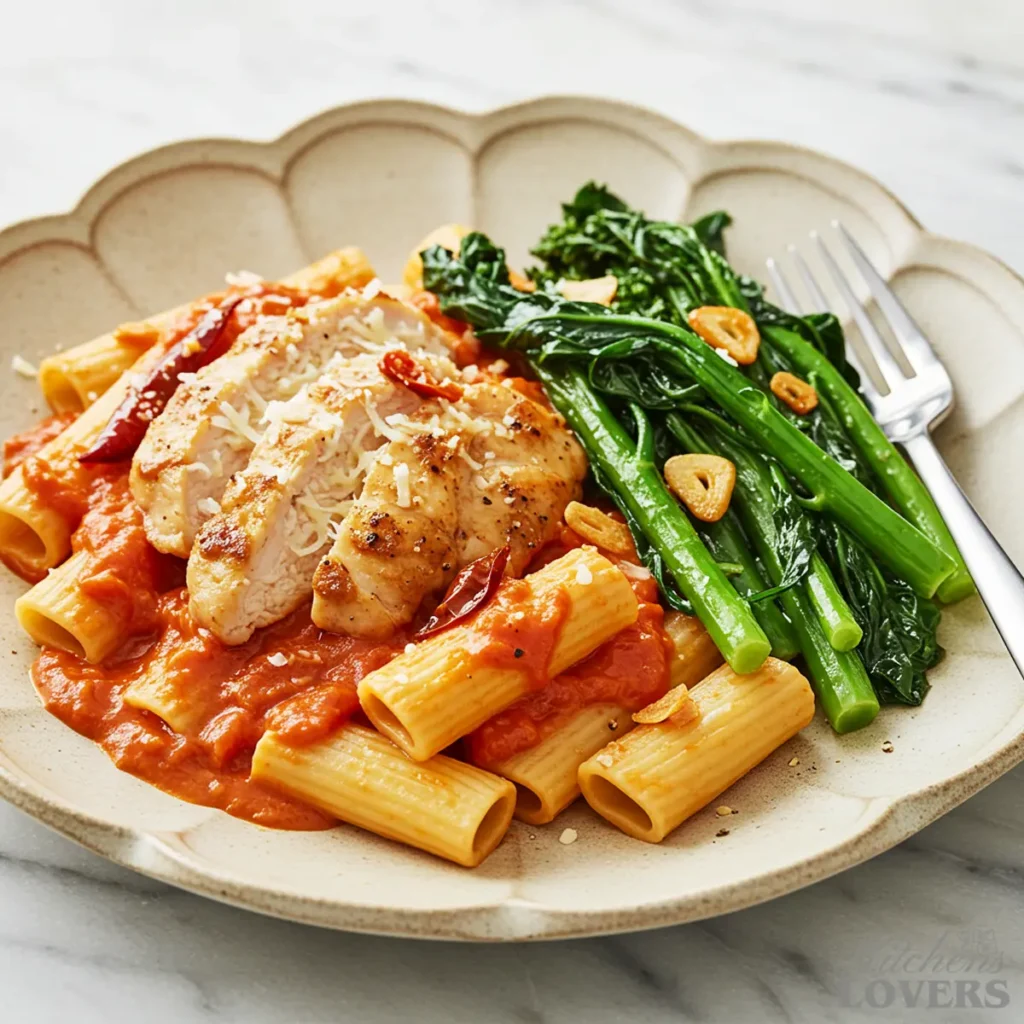
Why it works: This is a classic, rustic Italian pairing for a reason. Broccoli rabe (or rapini) has a pleasant, assertive bitterness that is the ultimate counterpoint to a rich and spicy red sauce. It completely resets your palate and prevents the meal from feeling heavy. Sautéing it simply with garlic and olive oil echoes the flavors already in the pasta, tying the whole plate together.
How to make it: Blanch a bunch of broccoli rabe in salted boiling water for 2 minutes, then drain. Sauté a few sliced cloves of garlic in olive oil in a skillet until fragrant, add the blanched broccoli rabe, and toss until tender. Finish with a pinch of salt.
A Bright, Crisp Intermission: Fennel and Orange Salad
Why it works: This salad is a burst of pure, vibrant freshness. The fennel is incredibly crisp with a subtle anise flavor, while the sweet, juicy oranges provide both sweetness and a gentle acidity that livens everything up. There is no heavy dressing, just a simple vinaigrette, so its primary job is to provide a clean, crunchy, and juicy contrast to every spicy bite of pasta.
How to make it: Very thinly slice one fennel bulb and segment two oranges, tossing them together. Add a handful of Kalamata olives for a briny kick. Dress simply with extra virgin olive oil, a splash of white wine vinegar, salt, and pepper.
Frequently Asked Questions (FAQs)
I get a lot of great questions about this recipe, and a few pop up consistently. I’ve gathered the most common ones here to answer them proactively and make sure you feel completely confident tackling this dish.
Understanding Fra Diavolo
“Fra Diavolo” translates from Italian to “Brother Devil.” It’s an Italian-American term that refers to the fiery, spicy nature of a dish, usually a tomato-based sauce served with seafood or pasta. While it sounds intimidating, remember that in this recipe, you are in complete control of the “devil’s” heat level.
Absolutely! In fact, this recipe was specifically developed to be completely wine-free without sacrificing any depth of flavor. Many recipes use white wine to deglaze the pan and add acidity, but I’ve found that between the high-quality tomatoes, the aromatic spices, and our secret weapon—the starchy pasta water—you create a sauce with more than enough complexity and richness. You lose nothing by leaving the wine out here.
Cooking Tips and Variations
This is the single most common frustration with Fra Diavolo recipes, and it’s the exact problem I designed this recipe to solve! If your sauce feels thin, it almost always comes down to the final, critical step. Ask yourself these questions:
Did I pull the pasta from the boiling water 1-2 minutes before it was al dente? It needs this time to finish cooking in the sauce.
Did I reserve and use the cloudy, starchy pasta water? This is non-negotiable. Plain water won’t work. This “liquid gold” is the emulsifier.
Did I toss the pasta, sauce, and pasta water together vigorously in the pan over the heat for at least 60-90 seconds? The friction and heat are what “activate” the starches, creating the creamy, clingy sauce.
If your sauce is still a bit loose, just keep tossing it over the heat for another 30 seconds. You’ll see it tighten up right before your eyes.
Yes, and I often prefer them! Boneless, skinless chicken thighs are naturally more flavorful and have a slightly higher fat content, which makes them incredibly forgiving—they are very difficult to overcook. You can pound them and sear them exactly as you would chicken breasts. Just be sure to trim any large pieces of excess fat before you start. The cooking time will be nearly identical.
Share Your Success & Discover More!
There is nothing I love more than seeing my recipes come to life in your home kitchens. If you made this dish, I would be thrilled to know how your Chicken Fra Diavolo Pasta turned out!
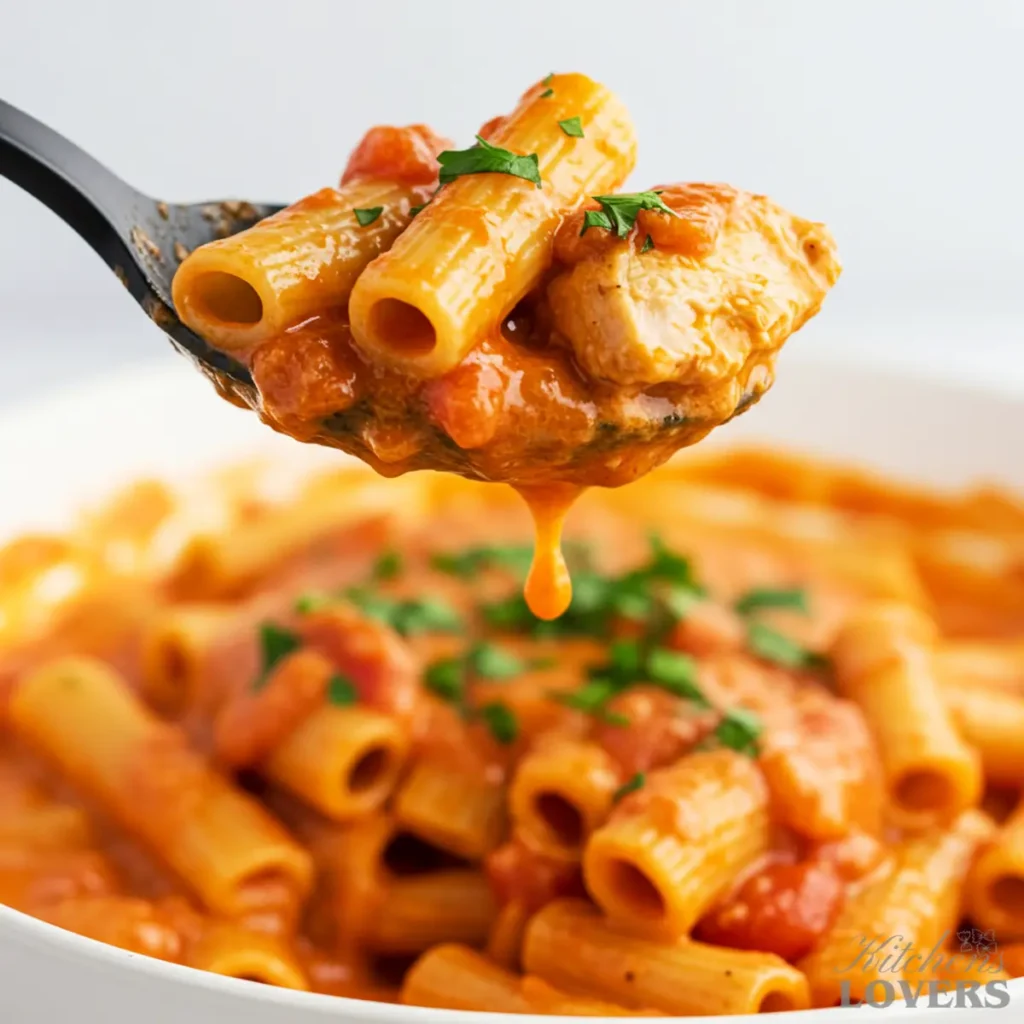
Please leave a comment and a star rating below to share your experience. Did you dial up the heat? Did you try the creamy variation? Your feedback not only makes my day, but it also helps other home cooks discover and trust this recipe.
And if you’re looking for your next delicious dinner, I think you’ll love these other tried-and-true recipes from my kitchen:
- For another classic Italian-American meal turned into a perfect pasta dish, try my rustic Chicken Cacciatore Pasta.
- If you love the bold, zesty flavors in this recipe, you have to make my spicy Blackened Chicken Pasta next.
- And for a milder, universally loved family staple, you can never go wrong with a perfect Chicken Pasta with Marinara Sauce.
Want more foolproof recipes?
Join the KitchensLovers family! Sign up for our free newsletter to get my latest easy, flavor-packed dinner ideas sent straight to your inbox. You’ll never wonder what to make for dinner again.
About the Author
Kate Thompson created KitchensLovers.com to simplify dinner for real-life families. She develops easy, flavor-packed chicken pasta recipes tested dozens of times to guarantee results. Her motto: ‘Easy Pasta, Every Time.’
The Flavor Science of a Perfect “Diavolo” Sauce
Have you ever noticed how some spicy sauces just taste… flat? It’s a one-note, aggressive burn. But a truly great spicy sauce feels vibrant, complex, and exciting. That difference isn’t an accident; it’s a deliberate technique rooted in a little bit of food science. Building our perfect “Diavolo” sauce relies on this science of layered heat.
Building the Foundation: Fat-Soluble Flavor
It all begins with how we treat our dried chiles—the red pepper flakes and the Calabrian chiles. The compounds that create the sensation of heat, primarily capsaicin, are fat-soluble. They dissolve in oil, not water. This is a critical fact. When we “bloom” the dried chiles in the hot olive oil at the very beginning of building our sauce, we are using that hot fat as a solvent. It actively pulls the capsaicin and, just as importantly, the unique aromatic oils from the chiles, infusing the entire pan with their essence. For Calabrian chiles, this means unlocking their signature smoky, fruity undertones. This creates a deep, foundational, rumbling warmth that permeates every molecule of the sauce as it simmers. It’s the persistent, satisfying heat you feel in the back of your throat.
The Final Spark: Bright, Fresh Heat
But we don’t stop there. If we only used that one technique, the flavor would be deep but might lack excitement. That’s why adding an optional fresh chili, like a serrano, at the very end is so impactful. The heat compounds in a fresh chili are still locked in its cellular structure and haven’t been mellowed by heat and time. Adding them right before serving provides a completely different kind of spice—a bright, sharp, top-note heat that zings the front of your tongue. It’s a fresh, almost grassy spice that provides a thrilling contrast to the deeper, richer heat.
By combining these two methods—the deep, oil-bloomed warmth and the bright, fresh pop—we create a truly three-dimensional flavor experience. You have a base note, a mid-range of flavor from the garlic and tomatoes, and a high note, all working in harmony. This is the difference between a simple, fiery sauce and a sophisticated, devilish one with a truly compelling story to tell. It’s how you build flavor with intention.
This recipe was last tested and updated in August 2025 to ensure perfect results.
Chicken Fra Diavolo Pasta Recipe
Equipment
- Large, Wide Skillet or Dutch Oven (12-inch or larger)
- Large Pot (for pasta)
- Spider Strainer or Tongs
- Cutting Board & Sharp Knife
Ingredients
For the Chicken & Pasta
- 1.5 pounds boneless skinless chicken breasts or thighs, pounded into ½-inch thick cutlets
- 1 pound dry rigatoni or penne pasta
- 3 tablespoons extra virgin olive oil divided
- Salt and freshly ground black pepper
For the Diavolo Sauce
- 1 large shallot finely chopped
- 6-8 cloves garlic thinly sliced
- 1 teaspoon crushed red pepper flakes adjust to taste
- 2-3 whole dried Calabrian chiles finely chopped
- 1.5 teaspoons dried oregano
- 1 teaspoon dried basil
- 1 28-ounce can San Marzano-style crushed tomatoes
For Finishing
- 1.5 cups hot starchy pasta water reserved
- ¼ cup fresh Italian parsley finely chopped, plus more for garnish
- 1 fresh serrano or fresno chili thinly sliced (optional, for garnish)
Instructions
Phase 1: Prep and Sear the Chicken
- Pat the chicken cutlets completely dry and season both sides generously with salt and pepper.
- Heat 2 tablespoons of olive oil in a large skillet or Dutch oven over medium-high heat until shimmering. Sear the chicken for 3-4 minutes per side, until golden brown and just cooked through. Transfer to a plate. Do not wipe out the pan.
Phase 2: Build the Diavolo Sauce
- Get a large pot of water boiling for your pasta. Salt it generously.
- Reduce skillet heat to medium, add the remaining 1 tablespoon of olive oil, the crushed red pepper flakes, and Calabrian chiles. Sizzle for 30-45 seconds to bloom the spices.
- Add the shallot and cook for 3 minutes until softened. Add the sliced garlic and cook for 60 seconds more until fragrant.
- Pour in the crushed tomatoes, dried oregano, and dried basil. Scrape up any browned bits from the bottom. Bring to a simmer, then reduce heat to low and let it gently bubble for at least 10 minutes.
Phase 3: Finish the Pasta in the Sauce
- Add pasta to the boiling water and cook for 2 minutes LESS than package directions for al dente.
- Before draining, reserve 2 cups of the starchy pasta water. Transfer the undercooked pasta directly into the skillet with the sauce.
- Chop the seared chicken and add it back to the skillet. Add 1 cup of the reserved pasta water.
- Turn heat to medium-high and toss everything vigorously for 1-2 minutes. The sauce will thicken and become glossy, coating the pasta. If it’s too thick, add another splash of pasta water.
- Turn off the heat. Stir in the fresh parsley and optional fresh chili. Serve immediately.
Notes
- The Secret to a Clingy Sauce: The magic is finishing the undercooked pasta in the sauce with starchy pasta water. The heat and friction emulsify the sauce, making it glossy and thick. If it’s too thin, toss for another 30 seconds. If too thick, add a splash of plain hot water.
- Key to Juicy Chicken: Pound chicken to an even ½-inch thickness so it cooks quickly without drying out. Don’t overcook it during the initial sear.
- Storage & Reheating: Store leftovers in the fridge for up to 3 days. Reheat gently in a skillet on the stovetop with a splash of water or broth—never the microwave!
- Pro Freezing Method: For best results, freeze the chicken and sauce mixture *before* adding the pasta. When ready to serve, thaw the sauce, reheat it, and cook a fresh batch of pasta to finish in the sauce.
- Variations: For a creamy ‘Rosé Devil’ sauce, stir in ¼ cup of cold heavy cream after turning off the heat. For a ‘Surf & Turf’, add ½ lb of raw shrimp along with the chicken and pasta in the final step.
